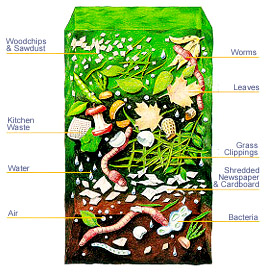
You can make composting as easy and cheap as that leaf-dropping tree. All you need are the ingredients and as much time as you are willing to devote to the project.
For the sake of appearances, or ease of handling, you may wish to enclose the pile in a bin. My favorite siding for this job is a 10- to 12 1/2-foot length of 48-inch-wide hardware cloth, 1/2- by 1-inch mesh. It is sturdy enough to be freestanding, forms a circle of perfect dimensions for composting, and won't leak any small pieces of the pile. Bend over a few of the wires on one edge to form hooks to attach it to the other edge in a cylinder. It's cheap, easy to use, lasts forever, and stores almost anywhere. Lumber scraps and chicken wire, salvaged concrete blocks, or bales of straw arranged together will also serve the purpose.
The dimensions of the pile affect how quickly it breaks down. Research has determined that the pile must be at least 3 feet high by 3 feet across in order to have enough mass to retain the heat generated in composting. As the microbes work, temperatures can reach 140°F inside the pile. These high temperatures kill weed seeds and disease organisms. Piles about 4 feet by 4 feet will work fine, but piles much larger than 5 feet around take a lot of work to keep actively composting. Larger
piles require constant turning to keep oxygen supplied to those busy microbes.
There are no hard and fast rules for building a compost pile. Gardeners generally recommend layering nitrogen materials and carbon materials with a bit of soil, with finished compost or activator sprinkled throughout the pile as it is built. The first time you turn the pile this neat arrangement is shot. The most convenient way to compost is to toss in whatever is available at the moment. Weeds go in when you pull them, soil, and all. Toss in eggshells, coffee grounds, and melon rinds after breakfast. Throw cornstalks on the pile at the end of summer.
You can add many items whole to the compost pile, and they will degrade fine. But larger items, such as cornstalks, hedge trimmings, and spent broccoli plants, will break down much more quickly if chopped into smaller pieces first. When they are cut into pieces there is much more surface area on which the microbes can work. Reduce large pieces by running over a shallow pile of them with a lawn mower, hacking with an ax, or throwing them in a chipper/shredder.
Keep the pile moist as you add materials to it. An occasional sprinkling with the garden hose provides the microbes with water they need to survive. Don't let piles get dripping wet, however, as precious plant nutrients will leach out. Cover your pile during rainy weather or if it is within sprinkler range.
Turning the pile provides aerobic conditions for you and the pile. You get the exercise, and the pile gets a fresh supply of oxygen for those hard-working microbes. If using a bin, disassemble it, grab a fork, and start working. Turn the outsides of the old pile into the center so they will be exposed to microbial action. Sprinkle the pile with water intermittently as you turn it. The more frequently you turn the pile, the more quickly the compost will decompose.
 So much of the information already discussed contributes to your plants' overall health. The best site, proper planting, and transplanting, using resistant varieties, adequate watering, drainage, and nutritional support all help keep plants in optimum condition. Healthy plants have an edge. They are less susceptible to physical stress, attack by disease, or infestation of pests. In fact, studies show insects recognize and prefer ailing plants.
So much of the information already discussed contributes to your plants' overall health. The best site, proper planting, and transplanting, using resistant varieties, adequate watering, drainage, and nutritional support all help keep plants in optimum condition. Healthy plants have an edge. They are less susceptible to physical stress, attack by disease, or infestation of pests. In fact, studies show insects recognize and prefer ailing plants. 
 Many gardeners buy compost starters to get a pile fired up. These are basically high-nitrogen products that may or may not work, depending on what else is in your pile. Fresh green weeds, with a little soil clinging to their roots, or a shovelful of soil or compost, tossed at intervals into the pile will suffice. But for a great, cheap pile activator, try alfalfa. Toss in handfuls from bales (old or rained-on bales are the cheapest) or use an alfalfa meal product. Horse feed, rabbit food pellets, even some brands of cat litter, are almost pure alfalfa meal.
Many gardeners buy compost starters to get a pile fired up. These are basically high-nitrogen products that may or may not work, depending on what else is in your pile. Fresh green weeds, with a little soil clinging to their roots, or a shovelful of soil or compost, tossed at intervals into the pile will suffice. But for a great, cheap pile activator, try alfalfa. Toss in handfuls from bales (old or rained-on bales are the cheapest) or use an alfalfa meal product. Horse feed, rabbit food pellets, even some brands of cat litter, are almost pure alfalfa meal.  You can make composting as easy and cheap as that leaf-dropping tree. All you need are the ingredients and as much time as you are willing to devote to the project.
You can make composting as easy and cheap as that leaf-dropping tree. All you need are the ingredients and as much time as you are willing to devote to the project.